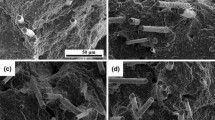SUMMARY
It was first shown that transcrystallization can be induced in syndiotactic polypropylene (sPP) when a carbon fiber (CF) of high-modulus (HM) is embedded in the melt of sPP crystallizing under quiescent conditions. High-tenacity carbon fiber (HTCF), on the other hand, did not cause transcrystalline growth. Coating of HMCF by silicon carbide (SiC) stopped the transcrystallization of sPP. The difference in the morphology of the transcrystalline layer between isotactic PP (iPP) and sPP was revealed by phase contrast light (PCLM), scanning electron (SEM) and atomic force microscopy (AFM) taken from the etched surface of single fiber microcomposite specimens.
Similar content being viewed by others
Author information
Authors and Affiliations
Additional information
Received: 31 March 1998/Revised version: 29 May 1998/Accepted: 10 June 1998
Rights and permissions
About this article
Cite this article
Wu, CM., Chen, M. & Karger-Kocsis, J. Transcrystallization in syndiotactic polypropylene induced by high-modulus carbon fibers. Polymer Bulletin 41, 239–245 (1998). https://doi.org/10.1007/s002890050357
Issue Date:
DOI: https://doi.org/10.1007/s002890050357




